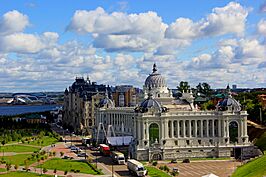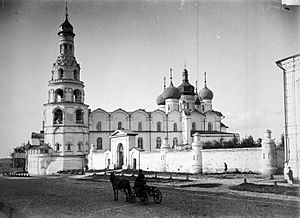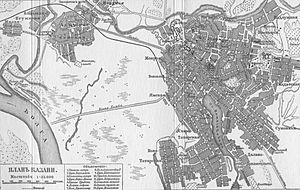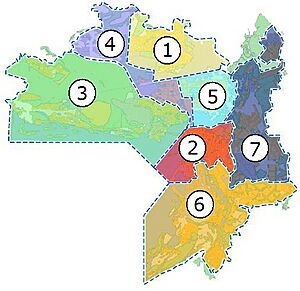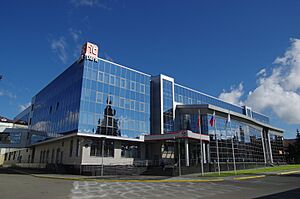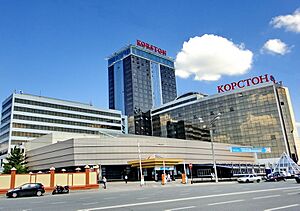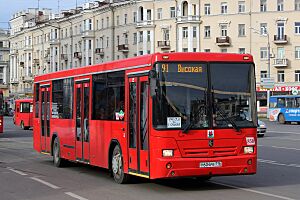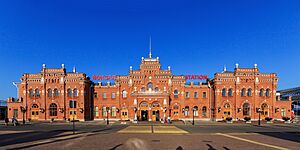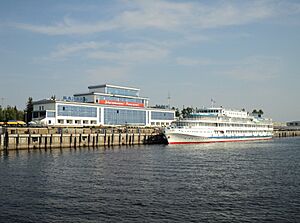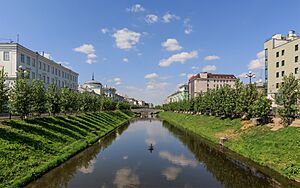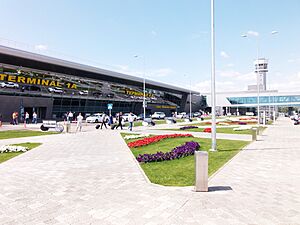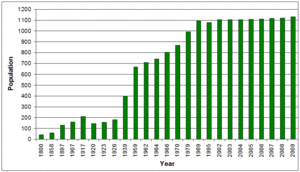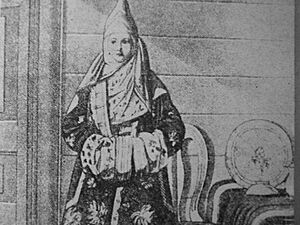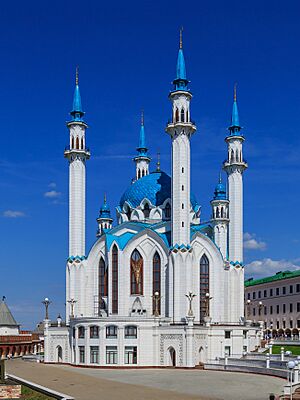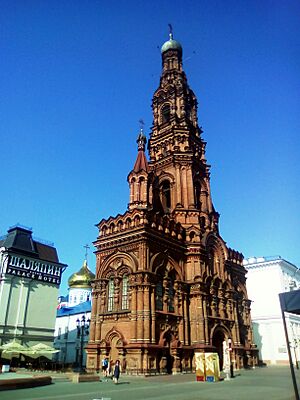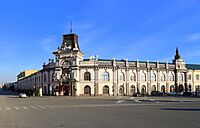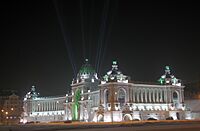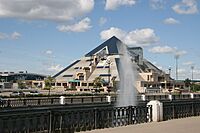Kazan facts for kids
Quick facts for kids Kazan (English)Казань (Russian) Казан (Tatar) |
|
|---|---|
| - City - City of republic significance |
|
| [[File:
|250px]] Top-down, left-to-right: View to the Agricultural Palace and Palace Square; Spasskaya Tower; Kul Sharif Mosque; Söyembikä Tower at night; Epiphany Cathedral and Bauman Street; and a view of the Kazan Kremlin. |
|
|
|
|
| City Day | 30 August |
| Administrative status | |
| Country | Russia |
| Federal subject | Tatarstan |
| Administratively subordinated to | City of republic significance of Kazan |
| Capital of | Republic of Tatarstan |
| Municipal status | |
| Urban okrug | Kazan Urban Okrug |
| Mayor | Ilsur Metshin |
| Representative body | City Duma |
| Statistics | |
| Area | 425.3 km2 (164.2 sq mi) |
| Population (2010 Census, preliminary) |
1,143,535 inhabitants |
| - Rank in 2010 | 8th |
| Density | 2,689/km2 (6,964/sq mi) |
| Time zone | MSK (UTC+04:00) |
| Founded | 1005 |
| Postal code(s) | 420xxx |
| Dialing code(s) | +7 843 |
| Official website: http://www.kzn.ru/ | |
Kazan is a large city and the capital of Tatarstan, a republic in Russia. It sits where the Volga River and the Kazanka River meet. The city covers about 425 square kilometers and is home to over 1.3 million people. It is the fifth-largest city in Russia and the biggest city along the Volga River.
Kazan has a long and interesting history. It was once the capital of the Khanate of Kazan, a powerful state. In the 16th century, Ivan the Terrible conquered the city, and it became part of Russia. The city was later rebuilt after being largely destroyed during a big uprising called Pugachev's Rebellion (1773–1775). Over time, Kazan grew into an important center for industry, culture, and religion in Russia. In 1920, it became the capital of the Tatar Autonomous Soviet Socialist Republic. After the Soviet Union ended, Kazan remained the capital of the Republic of Tatarstan.
Today, Kazan is famous for its unique blend of Tatar and Russian traditions. Millions of tourists visit Kazan each year. The Kazan Kremlin, a historic fortress, is a World Heritage Site and a major attraction. In 2009, Kazan was officially named the "Third Capital of Russia" and also the "sports capital of Russia." It has hosted many big events, including the 2013 Summer Universiade (a major international sports event for university athletes) and games for the 2018 FIFA World Cup. In June 2024, Kazan also hosted the BRICS Games, where athletes competed in 27 different sports.
Contents
- Understanding the Name of Kazan
- Kazan's Rich History
- Kazan's Symbols: Heraldry
- How Kazan is Organized
- Kazan's Economy
- Getting Around Kazan: Transportation
- People of Kazan: Demographics
- Kazan's Climate and Geography
- Exploring Central Kazan
- Kazan's Cityscape
- Learning and Science in Kazan
- Communication in Kazan
- Sports in Kazan
- Kazan's International Connections
- Images for kids
- See also
Understanding the Name of Kazan
The name "Kazan" comes from a word that means 'boiler' or 'cauldron' in the Tatar and Turkic languages. There are a few stories about how the city got its name.
Legends and Stories Behind Kazan's Name
One legend says that a wise person told the Bulgars (an ancient people) to build a city where a boiler, buried in the ground, would boil water without any fire. They found such a place near Kaban Lakes, and that's where the city was built. Another story suggests the city was named after the Kazanka River. This river, in turn, was named after a Bulgar governor's son who accidentally dropped a copper cauldron into it.
An old text from 1776 also talks about the name. It says that Kazan Tatars got their name from the city of Kazan. The city itself was named after a cauldron (Kazan in Tatar) that a servant of Khan Altyn Bek dropped into the river while getting water for his master.
Kazan's Rich History
Kazan has a long and exciting history, stretching back over a thousand years.
Early Days: The Middle Ages
Historians believe Kazan was founded around 1004–1005 AD. This date was chosen after archaeologists found an old Czech coin from the 10th century, along with ancient walls, tools, and other items during digs in the Kazan Kremlin. Experts from many countries helped study these findings.
Kazan started as a border outpost between Volga Bulgaria and two Finno-Ugric peoples (the Mari and Udmurt). Evidence of early settlements has been found in three parts of the modern city: the Kremlin, Bişbalta, and near Lake Kaban. The Kremlin area seems to be the oldest.
After the Mongols attacked the Bolğar and Bilär lands in the 13th century, many Bulgars survived. They mixed with a group called Kipchaks, which led to the modern Kazan-Tatar people and their language. Kazan became an important center within the Golden Horde, a large empire. It grew as a trade and political hub because it was located where major trade routes between East and West crossed. During this time, Kazan even started making its own coins.
In 1438, a Golden Horde leader named Ulugh Muhammad captured the old Bulgar fortress of Kazan. He moved the city to its current location, and it became the capital of the Khanate of Kazan. The city's market, Taş Ayaq, became a very important trading place, especially for furniture. Kazan was also known for its beautiful leather and gold products, and its rich palaces and mosques. It traded with places like Moscow, Crimea, and Turkey.
Russian Tsardom Period: Changes and Rebuilding
In 1552, Tsar Ivan the Terrible conquered Kazan after a long siege of Kazan. After this, many Tatar residents were forced to become Christians or move away. Mosques and palaces were destroyed. The remaining Tatar people were moved to a new settlement about 50 kilometers from the city. Russian farmers and soldiers then settled in Kazan. Later, Tatar merchants and craftspeople also moved back to a special area near the city wall.
During this period, Kazan suffered from several big fires. After one fire in 1579, a famous religious icon called Our Lady of Kazan was discovered in the city. In the early 17th century, Kazan briefly declared independence during a time of trouble in Russia, but this was quickly stopped.
Russian Empire Period: Growth and Modernization
In 1708, Kazan became the center of the Kazan Governorate. After Peter the Great visited, the city became a key place for building ships for the Caspian fleet. The famous Russian poet Gavrila Derzhavin was born in Kazan in 1743.
Kazan faced many challenges, including major fires in different years. In 1774, the city was largely destroyed during Pugachev's Rebellion. However, it was quickly rebuilt with stone buildings and a new grid-like street plan under the rule of Catherine the Great. Catherine also allowed mosques to be built again in Kazan, with the Marjani Mosque being the first.
In the early 1800s, Kazan State University and a printing press were founded. Kazan became an important center for studying Eastern cultures. The Qur'an was first printed in Kazan in 1801. The city also grew as an industrial center, attracting many workers. Horse trams appeared in 1875, followed by electric trams in 1899. After the Russian Revolution of 1905, Tatars were allowed to bring back Kazan as a Tatar cultural center. The first Tatar theater and newspaper were created.
Soviet Period: Industrial Hub
In 1917, Kazan was a key location during the October Revolution. In 1920, it became the capital of the Tatar Autonomous Soviet Socialist Republic. During World War II, many factories from western Russia were moved to Kazan. This made the city a major center for the military industry, producing tanks and planes. After the war, Kazan continued to grow as an industrial and scientific hub. By 1979, the city's population reached one million people.
Modern Period: Renovation and Global Events
In the late 1980s and 1990s, after the dissolution of the Soviet Union, Kazan once again became a strong center for Tatar culture. With the return of capitalism, Kazan became one of the most important cities in Russia. Its population ranking among Russian cities improved. In the early 2000s, Kazan won the right to host the 2013 Summer Universiade and the 2018 FIFA World Cup.
Kazan's Millennium Celebration
Since 2000, Kazan has undergone a huge renovation. The historic center, including the Kremlin, was rebuilt. In 2005, Kazan celebrated its 1000th birthday. During these celebrations, the Qolsharif Mosque was opened in the Kazan Kremlin, a holy copy of the Our Lady of Kazan icon was returned to the city, the Millennium Bridge was opened, and the Kazan Metro started running.
For the 2013 Universiade, Kazan continued to modernize its airport, fix streets, improve public transport, and add Russian, English, and Tatar languages to all transportation and large stores.
Kazan's Symbols: Heraldry
The official symbol of Kazan is a mythical dragon-like creature called Zilant. This creature is often mentioned in local legends.
The Legend of Zilant
One legend says that many snakes and reptiles made it hard to build the city. Hunters went to find the King of snakes and defeated it. Another version says the city's people paid off a giant snake with gold, and all the snakes left. Some legends claim the dragon-like serpent still guards hidden treasures from before the city was captured. Historically, there were many snakes in the Kazan region, but their numbers have greatly decreased.
Official Coat of Arms
Kazan's first official coat of arms was approved in 1781. It showed a "black snake under a gold crown, with red wings, on a white field." In the 1980s, the Zilant symbol started appearing again. The modern design of the emblem and flag appeared in 2005. It shows a black dragon with red wings and tongue, with gold paws, claws, and eyes, on a silver field with green earth. A special Kazan cap sits above the shield. In heraldry, the dragon represents power, wisdom, and strength. The earth means life and wealth, the crown means development, and the cap above the shield shows that Kazan is a capital city.
How Kazan is Organized
Kazan is the capital of Tatarstan. It is an administrative unit with the same status as a district. For local government, it is known as the Kazan Urban Okrug.
City Districts
Kazan is divided into seven main districts:
| No. | District | Population | Area (km2) |
|---|---|---|---|
| 1 | Aviastroitelny | 111,405 | 38.91 |
| 2 | Vakhitovsky | 86,202 | 25.82 |
| 3 | Kirovsky | 109,125 | 108.79 |
| 4 | Moskovsky | 130,537 | 38.81 |
| 5 | Novo-Savinovsky | 202,997 | 20.66 |
| 6 | Privolzhsky | 227,755 | 115.77 |
| 7 | Sovetsky | 275,514 | 167.00 |
Kazan's Economy
Kazan is one of Russia's biggest industrial and financial centers. It is a leading city in the Volga economic region for construction and investments. In 2011, the city's total economic output was 380 billion rubles.
Key Industries and Investments
The main industries in Kazan include mechanical engineering, chemical production, petrochemicals, and light and food industries. The city also has a strong innovative economy, with one of the largest IT-parks in Russia. Kazan has been ranked among the "Best cities for business in Russia" by Forbes.
In 2011, businesses in Kazan attracted over 87 billion rubles for economic and social development. This was a 44% increase from 2010. Kazan has been a leader in house construction in the Volga region and has a unique program to replace old, rundown housing.
Getting Around Kazan: Transportation
Kazan has a well-developed public transport system, including buses, trams, trolleybuses, and a metro.
Bus System
Buses are the most popular way to get around Kazan, carrying about 74% of passengers. The city has about 62 bus routes, covering over 1,200 kilometers. All 840 buses are red and are tracked by satellite. The bus system was fully updated in 2007. The fare is 42 rubles in cash or 38 rubles with a credit or transport card (as of January 2024).
Tram System
Kazan's tram system is one of the oldest in Russia, starting in 1899. It has eight routes, including a special historical tour route. Many tram lines are on dedicated tracks. In the 2000s, some lines in the city center were removed to help with traffic. However, new lines have been built, creating circular routes. Tram announcements are in Russian, Tatar, and English. The fare is 42 rubles in cash or 38 rubles with an electronic card (2024).
Trolleybus System
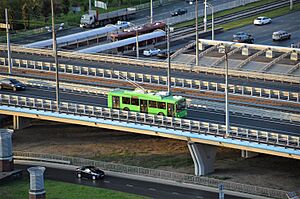
Kazan's trolleybus system also began long ago, in 1948. It continues to grow, with new lines replacing some old tram routes. There are over 200 green trolleybuses serving 10 routes. All trolleybuses are monitored by satellite. As of June 2024, the fare is 42 rubles in cash or 38 rubles with an electronic or debit card.
Metro System
The Kazan Metro opened in 2005. It has a single line running north to south-east with eleven stations. A second metro line is currently being built (February 2024).
Railways
Kazan is connected by train to major cities like Moscow and Yekaterinburg. The main railway station, Kazan–Passazhirskaya, is in the city center and serves millions of passengers each year. There is also a second station, "Kazan-2," in the northern part of the city, and 19 platforms for local commuter trains.
Cycling
Kazan launched a bicycle sharing system called Veli'k in 2013. It has seven docking stations and 100 bikes. In 2015, the first separate bike lanes were opened in the city center, with plans for more throughout the city.
Waterways
Kazan's river port is one of the largest on the Volga River. Because of its system of canals, Kazan is sometimes called the "port of five seas." The river station serves both long-distance cruise ships and local boats. In winter, special hovercraft boats are used.
Highways and Bridges
Kazan has federal highway connections to cities like Moscow and Ufa. There are five bridges over the Kazanka River within the city and one bridge connecting Kazan to the other side of the Volga River.
Intercity Buses
Kazan has two bus stations, Central and Southern. Bus routes connect Kazan to all districts of Tatarstan and many other cities in Russia.
Kazan International Airport
Kazan International Airport is about 26 kilometers from the city center. It is a hub for two airlines and serves many air companies. You can reach the airport by bus or suburban train. Kazan also has the Kazan Borisoglebskoye airfield, home to a major aircraft factory that builds planes like the Tupolev 204 and 214.
People of Kazan: Demographics
Population Growth
| Historical population | ||
|---|---|---|
| Year | Pop. | ±% |
| 1897 | 130,000 | — |
| 1926 | 175,597 | +35.1% |
| 1939 | 398,014 | +126.7% |
| 1959 | 646,806 | +62.5% |
| 1970 | 868,537 | +34.3% |
| 1979 | 992,675 | +14.3% |
| 1989 | 1,094,378 | +10.2% |
| 2002 | 1,105,289 | +1.0% |
| 2010 | 1,143,535 | +3.5% |
| 2021 | 1,308,660 | +14.4% |
| Source: Census data | ||
Kazan's population is 1,308,660 as of 2021. The larger Kazan metropolitan area has about 1.8 million people.
Ethnic Groups in Kazan
The city's population is mainly made up of Tatars (48.8%) and Russians (46.9%). Other ethnic groups include Chuvash, Uzbeks, Tajiks, Azerbaijanis, and Mari.
Religions in Kazan
Religion in Kazan (2024) Islam (52.5%) Orthodox (43%) Other Christian (2%) Judaism (1%) Other religions and non-religious individuals (1.5%)
The main religions in Kazan are Islam and Eastern Orthodox Christianity. There are also smaller groups of Roman Catholics, Protestants, Jews, and followers of the Baháʼí Faith.
Languages Spoken
The most common language spoken in Kazan is Russian. The Tatar language is the second most common.
Kazan's Climate and Geography
Weather in Kazan
| Weather chart for Kazan | |||||||||||||||||||||||||||||||||||||||||||||||
|---|---|---|---|---|---|---|---|---|---|---|---|---|---|---|---|---|---|---|---|---|---|---|---|---|---|---|---|---|---|---|---|---|---|---|---|---|---|---|---|---|---|---|---|---|---|---|---|
| J | F | M | A | M | J | J | A | S | O | N | D | ||||||||||||||||||||||||||||||||||||
|
46
-7
-13
|
37
-6
-13
|
38
0
-7
|
34
11
2
|
38
20
9
|
57
24
14
|
62
26
16
|
55
24
14
|
50
17
9
|
54
9
3
|
45
-0
-5
|
50
-5
-11
|
||||||||||||||||||||||||||||||||||||
| temperatures in °C precipitation totals in mm source: http://www.pogodaiklimat.ru/climate/27595.htm |
|||||||||||||||||||||||||||||||||||||||||||||||
|
Imperial conversion
|
|||||||||||||||||||||||||||||||||||||||||||||||
Kazan has a humid continental climate. This means it has long, cold winters and warm, sunny summers. Because it is far inland, summers can be very warm for its location, and winters are quite cold compared to places further west in Europe.
The warmest month is July, with an average daily temperature of about 20.2°C. January is the coldest month, with an average daily temperature of about -10.4°C. In 2010, Kazan experienced its two hottest days on record, with temperatures reaching 39°C during a heatwave.
| Climate data for Kazan (1991–2020, extremes 1812–present) | |||||||||||||
|---|---|---|---|---|---|---|---|---|---|---|---|---|---|
| Month | Jan | Feb | Mar | Apr | May | Jun | Jul | Aug | Sep | Oct | Nov | Dec | Year |
| Record high °C (°F) | 4.5 (40.1) |
5.6 (42.1) |
15.8 (60.4) |
29.5 (85.1) |
33.5 (92.3) |
37.5 (99.5) |
38.9 (102.0) |
39.0 (102.2) |
32.3 (90.1) |
23.4 (74.1) |
15.0 (59.0) |
6.1 (43.0) |
39.0 (102.2) |
| Mean daily maximum °C (°F) | −7.1 (19.2) |
−6.3 (20.7) |
0.3 (32.5) |
10.5 (50.9) |
19.7 (67.5) |
23.6 (74.5) |
25.8 (78.4) |
23.5 (74.3) |
16.8 (62.2) |
8.5 (47.3) |
−0.3 (31.5) |
−5.4 (22.3) |
9.1 (48.4) |
| Daily mean °C (°F) | −10.0 (14.0) |
−9.7 (14.5) |
−3.3 (26.1) |
5.8 (42.4) |
14.0 (57.2) |
18.3 (64.9) |
20.5 (68.9) |
18.3 (64.9) |
12.3 (54.1) |
5.3 (41.5) |
−2.5 (27.5) |
−8.0 (17.6) |
5.1 (41.2) |
| Mean daily minimum °C (°F) | −12.8 (9.0) |
−12.7 (9.1) |
−6.5 (20.3) |
1.9 (35.4) |
9.0 (48.2) |
13.5 (56.3) |
15.8 (60.4) |
13.9 (57.0) |
8.7 (47.7) |
2.7 (36.9) |
−4.5 (23.9) |
−10.5 (13.1) |
1.5 (34.7) |
| Record low °C (°F) | −46.8 (−52.2) |
−39.9 (−39.8) |
−31.7 (−25.1) |
−27.2 (−17.0) |
−6.5 (20.3) |
−1.4 (29.5) |
2.6 (36.7) |
1.0 (33.8) |
−5.4 (22.3) |
−23.4 (−10.1) |
−36.6 (−33.9) |
−43.9 (−47.0) |
−46.8 (−52.2) |
| Average precipitation mm (inches) | 46 (1.8) |
37 (1.5) |
38 (1.5) |
34 (1.3) |
38 (1.5) |
57 (2.2) |
62 (2.4) |
55 (2.2) |
50 (2.0) |
54 (2.1) |
45 (1.8) |
50 (2.0) |
566 (22.3) |
| Average extreme snow depth cm (inches) | 30 (12) |
42 (17) |
44 (17) |
9 (3.5) |
0 (0) |
0 (0) |
0 (0) |
0 (0) |
0 (0) |
0 (0) |
5 (2.0) |
16 (6.3) |
44 (17) |
| Average rainy days | 3 | 2 | 4 | 11 | 15 | 18 | 16 | 16 | 18 | 17 | 10 | 5 | 135 |
| Average snowy days | 26 | 22 | 16 | 6 | 1 | 0 | 0 | 0 | 1 | 7 | 20 | 24 | 123 |
| Average relative humidity (%) | 84 | 80 | 76 | 67 | 58 | 65 | 68 | 70 | 75 | 80 | 85 | 84 | 74 |
| Mean monthly sunshine hours | 35.6 | 71.9 | 144.4 | 213.0 | 290.1 | 308.6 | 316.1 | 253.0 | 156.3 | 78.0 | 32.9 | 21.4 | 1,921.3 |
| Source 1: Погода и Климат | |||||||||||||
| Source 2: NOAA | |||||||||||||
Exploring Central Kazan
The Kazan Kremlin
The city's main fortress, known as the Kremlin, was named a World Heritage Site in 2000. Inside the Kremlin, you can find several important buildings.
Key Kremlin Landmarks
- The five-domed Annunciation Cathedral (built 1561–62).
- The mysterious Söyembikä Tower, which used to lean. It's named after the last queen of Kazan and is a famous symbol of the city.
- The Kremlin's walls and towers, built in the 16th and 17th centuries and later rebuilt.
- The Qol-Şarif Mosque, which has been rebuilt inside the Kremlin.
- Parts of the Saviour Monastery, including the Spasskaya Tower.
- The Governor's House (1843–53), which is now the Palace of the President of Tatarstan.
Outside the Kremlin, but still in the center, are the beautiful Sts-Peter-and-Paul's Cathedral and the Marcani Mosque, both from the 18th century.
Kremlin Towers
- Spasskaya Tower: Built in the 16th century, this tower has two brick levels and a brick roof. It used to have the Russian state's coat of arms on top.
- South-Western Tower: Also built in the 16th century, it shows the classic Pskov style of defense.
- Transfiguration Tower: Named after a nearby monastery, this tower was also built by Pskov architects but later changed to look more like Moscow's defensive buildings.
- Tainitskaya Tower: Built in the 1550s, its name means "secret" because it had a hidden water source for use during a siege. Its entrance is shaped like a "knee" to make it harder for attackers to get in.
- Consistor Tower: Built in the 17th century, it was named after a religious office located nearby.
City Districts: Bistä and Posad
Central Kazan is split into two parts by the Bolaq canal and Lake Qaban.
- Qazan Bistäse (or Kazanskiy Posad): This area, historically Russian, is on a hill.
- İske Tatar Bistäse (or Staro-Tatarskaya Sloboda): This area, historically Tatar, is located between the Bolaq and the Volga.
You'll find mosques like Nurullah, Soltan, Bornay, Äcem, Märcani, İske Taş, and Zäñgär in the Tatar district. Churches like Blagoveschenskaya, Varvarinskaya, Nikol'skaya, and Tikhvinskaya are mostly in the Russian part.
The main streets in the city center include Bauman, Kremlyovskaya, Dzerzhinsky, Tuqay, Puşkin, Butlerov, Gorkiy, Karl Marx, and Märcani.
Wooden Kazan: A Look Back
In the early 1900s, much of Central Kazan had wooden buildings, usually two stories high. While these were part of the city's history, they weren't the best places to live. During a program to remove old apartments, many of these wooden buildings were torn down, especially in Central Kazan where land is valuable. Their residents moved to new areas on the city's outskirts.
Other Important Buildings
Another notable building in central Kazan is the former "Smolentzev and Shmelev" tea house and hotel, now the Shalyapin Palace Hotel. It's a great example of late 19th and early 20th-century business architecture.
Kazan's Cityscape
Learning and Science in Kazan
Schools and Colleges
Kazan has a strong education system, including:
- 282 nurseries (most are public)
- 178 schools (2 are private)
- 28 vocational technical schools
- 15 colleges
- 10 special colleges
The city also has 49 music schools, 43 sports schools, and 10 fine-arts schools, including the Kazan Art School founded in 1895.
Universities and Higher Education
Kazan is home to 44 higher education institutions, including 19 branches of universities from other cities. Over 140,000 students study in Kazan.
Kazan Federal University, founded in 1804, is the third oldest university in Russia. In 2009, it became a Federal university, serving as the main university for the Volga Region.
Other important universities include:
- Kazan State Technical University – founded in 1932, became a National university in 2009.
- Kazan State Medical University – started in 1814 as part of Kazan State University.
- Kazan State Technological University – founded in 1919.
- Kazan State Conservatory – founded in 1945.
- Kazan State Agricultural University - founded in 1922.
Scientific Discoveries and Centers
Kazan is a major scientific center in Russia. Many important scientific discoveries have been made here, such as:
- The creation of non-Euclidean geometry by Nikolai Lobachevsky.
- The discovery of the chemical element ruthenium by Karl Ernst Claus.
- The theory about the structure of organic compounds by Aleksandr Butlerov.
- The discovery of electron paramagnetic resonance by Yevgeny Zavoisky.
The city hosts:
- The Kazan Science Centre of the Russian Academy of Sciences, since 1945. It has 5 academic institutions.
- The Tatarstan Academy of Sciences, since 1991. It includes 7 local departments with 13 academic institutions.
Communication in Kazan
Kazan has 84 post offices. The city's telephone network started in 1888. Today, there are four wired telephone operators and six mobile operators. Kazan is a major center for information technology development, with a very high rate of Internet use (75%). Access to the Internet is provided by 15 operators, mostly through cable networks and ADSL.
Sports in Kazan
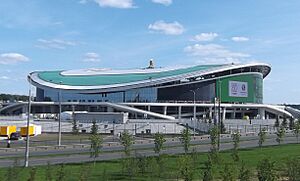
Kazan is one of Russia's most developed cities for sports. It has hosted many international competitions, including:
- Two Bandy World Championships (in 2005 and 2011).
- The World Summer Universiade 2013.
- The World Aquatics Championship FINA 2015.
- The 2017 FIFA Confederations Cup.
- The 2018 FIFA World Cup.
Professional Sports Teams
Kazan is home to several successful professional sports teams:
| Club | Sport | Founded | Current league | League rank |
Stadium |
|---|---|---|---|---|---|
| Rubin Kazan | Football | 1958 | Russian Premier League | 1st | Kazan Arena |
| Ak Bars Kazan | Ice Hockey | 1956 | Kontinental Hockey League | 1st | Tatneft Arena |
| Dynamo-Kazan | Bandy | 1958 | Bandy Super League | 1st | Raketa Stadium |
| UNICS Kazan | Basketball | 1991 | Professional Basketball League | 1st | Basket-Hall Arena |
| Zenit Kazan | Volleyball | 2000 | Volleyball Super League | 1st | Kazan Volleyball Centre |
| Sintez Kazan | Water Polo | 1974 | Water Polo Championship | 1st | Orgsintez |
Famous Athletes from Kazan
Many talented athletes come from Kazan, including:
- Aliya Mustafina, a famous artistic gymnast.
- Marat Safin and Dinara Safina, well-known tennis players.
- Kamila Valieva and Evgenia Tarasova, figure skaters.
Sports Facilities
Kazan has excellent sports facilities:
- Kazan Arena – a football stadium with 45,000 seats, home to FC Rubin.
- Central stadium – an Olympic stadium with 30,133 seats.
- TatNeft Arena – an indoor arena for ice hockey, home to HSC Aq Bars.
- Basket-Hall – an indoor arena for basketball, home to BC UNICS.
- Kazan Volleyball Centre – home to VC Zenit and WVC Dynamo-Kazan.
Kazan's International Connections
Kazan is very active in international relations. It has foreign offices for diplomacy, trade, and culture. The Kazan Kremlin and the Institute of Culture of Peace are supported by UNESCO. The city is part of many international city organizations.
Consulates and Visa Centers
Kazan is home to six consulates general, which are offices representing foreign governments. These include consulates for Iran, Turkey, Hungary, China, Kazakhstan, and Turkmenistan. There are also visa centers for countries like Italy and several European Union nations.
Twin Towns and Sister Cities
Kazan has "twin town" or "sister city" relationships with many cities around the world. These partnerships help promote cultural exchange and cooperation. Some of Kazan's twin cities include:
- Al Minufiyah, Egypt
- Ankara, Turkey
- Braunschweig, Germany
- College Station, United States
- Guangzhou, China
- Istanbul, Turkey
- Astana, Kazakhstan
- Tabriz, Iran
Kazan also has partner relationships with many other cities and regions, both within Russia and in other countries.
Images for kids
See also
 In Spanish: Kazán para niños
In Spanish: Kazán para niños


